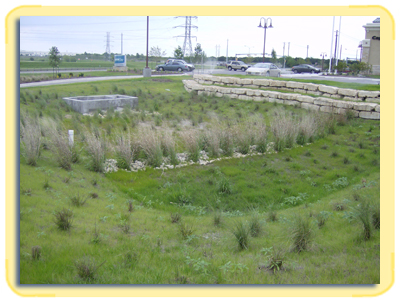Using physical and biological treatment mechanisms, biofiltration uses an organic filtration media with vegetation to remove pollutants. As with sedimentation/filtration systems, runoff is first diverted into a sedimentation basin, where particulate pollutants are removed via gravity settling. This is followed by filtration through an 18" layer of vegetated media.
Biofiltration systems are considered to provide a level of treatment equivalent to sedimentation/filtration, and also provide extended detention that enhances baseflow and reduces stream erosion. Biofiltration systems are not allowed in Barton Springs Zone (BSZ) watersheds as a stand-alone water quality control, as they are not capable of achieving a non-degradation level of treatment.
Because of the vegetation, biofiltration systems can be aesthetic amenities and may be eligible for landscape credit (unlike sedimentation/filtration systems). To ensure proper management of the pond system, filtration media, and vegetation, an Integrated Pest Management (IPM) Plan is required.
The current design criteria is similar to that for sedimentation/filtration systems, and two design alternatives are available. In “full” sedimentation/filtration systems the entire water quality volume is held in the sedimentation basin, which then slowly discharges runoff to the filtration basin via a perforated riser pipe. The alternative “partial” sedimentation/filtration design foregoes the perforated riser pipe, and distributes the water quality volume between the filtration basin and a sediment chamber, the latter separated from the filtration bed by a vegetated hedgerow. The “full” design is required when the City of Austin is responsible for maintenance.
Design guidelines for biofiltration can be found in Section 1.6.7.C of the Environmental Criteria Manual. For information on the biofiltration media, go to biofiltration media guidance. Also available is a list of potential suppliers.

